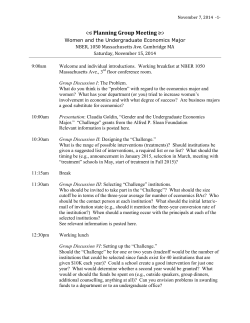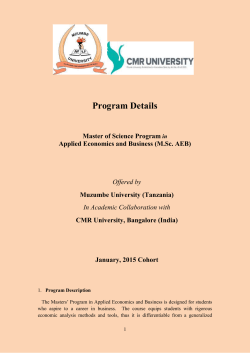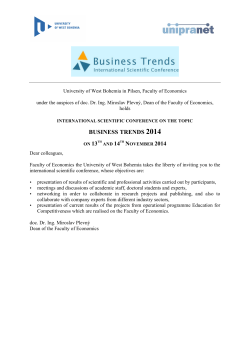
The University of Michigan Fall 2013 1.5 Credits
The University of Michigan Fall 2013 1.5 Credits Professor Gautam Ahuja R6356 – Ross School of Business Ph: 734-763-1591 E-Mail: gahuja@umich.edu CSIB 897 Doctoral Seminar in Corporate Strategy This doctoral seminar surveys the major theoretical perspectives used in strategic management (or strategy) research. Broadly speaking, research in strategy focuses (primarily) on the economic conduct and performance of firms. An illustrative list of the issues addressed in strategy research includes identifying the profit potential of industries, exploring relationships between firm scale, scope and performance, and understanding the managerial and organizational determinants of firm level outcomes. The course draws upon theoretical perspectives from economics, sociology and organization theory to supplement more traditional strategy approaches towards understanding firm performance and related issues. Many of the issues examined through these theoretical perspectives, for instance vertical integration, firm diversification, industry structure, organizational and inter-organizational networks, are also common themes in other disciplines such as industrial organization economics, accounting, marketing, information systems and organizational and economic sociology. Accordingly, this course may be useful to students with research interests in these areas. Course Requirements: Each student will be responsible for reading and contributing to the discussion of all articles listed in the syllabus. For each session you are expected to prepare a brief critique (maximum - two pages) of one of the articles that were required for that day's class. The article will Grading for the course will be based on class participation (50%) and an individual term paper (50%). The term paper should define a research question, review and critique the extant literature, develop a few testable hypotheses, and propose a method for testing the proposed hypotheses. Papers spanning strategy and other disciplines such as marketing, organization theory, or economics would also be acceptable subject to a prior approval of the subject matter by the instructor. Readings marked with an ** are optional / further readings. They are not required for the class and will not be discussed in class. READING LIST I Introduction and Overview Kim, Dong-Jae & Kogut, Bruce. 1996. Technology platforms and diversification. Organization Science, 7(3): 283-301. Morck. Randall & Yeung, Bernard. 1992. Internalization: An Event study test. Journal of International Economics, 33: 41-56. Arora, A. & Gambardella, A. 1990. Complementarity and External Linkages: The Strategies of the Large Firms in Biotechnology. The Journal of Industrial Economics, June: 361-379. Henderson, Rebecca. 1993. Underinvestment and Incompetence as Responses to Radical Innovation: Evidence from the Photolithographic Alignment Equipment Industry. Rand Journal of Economics. 24(2): 248-270. Singh, Kulwant & Mitchell, Will. 1996. Survival of Businesses Using Collaborative Relationships to Commercialize Complex Goods. Strategic Management Journal. 17(3): 169195. Ahuja, Gautam & Katila, Riitta, 2001. Technological acquisitions and the innovation performance of acquiring firms: A longitudinal study. Strategic Management Journal Pierce, Lamar. 2012. Organizational Structure and the Limits of Knowledge Sharing: Incentive Conflict and Agency in Car Leasing. Management Science, 2012 Innovation and Institutional Ownership 2013. Aghion, P. Van Reenen, J. and L. Zingales. American Economic Review 103(1): 277-304 PERSPECTIVES II Classical Industrial Organization Scherer, F. M. & Ross, David. 1990. Industrial Market Structure and Economic Performance (3rd Ed.), Ch. 1. Boston: Houghton Mifflin Co. Stigler, George J. 1964. A Theory of Oligopoly. Journal of Political Economy. 72(1): 44-61. Demsetz, Harold. 1973. Industry Structure, Market Rivalry, and Public Policy. Journal of Law and Economics. 16(1): 1-9. Schmalensee, Richard. 1985. Do Markets Differ Much? American Economic Review. 75(3): 341-351. Rumelt, Richard P. 1991. How Much Does Industry Matter? Strategic Management Journal. 12(3): 167-185. Schumpeter, J. F. 1950. Capitalism, Socialism and Democracy (3rd Ed.), Ch. 7-8. New York: Harper & Row. Managing with Style: The Effect of Managers on Firm Policies Marianne Bertrand, Antoinette Schoar. The Quarterly Journal of Economics. Cambridge: Nov 2003. Vol. 118, Iss. 4; p. 1169 **Wernerfelt, Birger & Montgomery, Cynthia A. Management Science. 32(10): 1223-1230. 1986. What is an Attractive Industry? 2 III Strategic Groups / New Industrial Organization Scherer, F. M. & Ross, David. 1990. Industrial Market Structure and Economic Performance (3rd Ed.), Ch. 11. Boston: Houghton Mifflin Co. McGee, John & Thomas, Howard. 1986. Strategic Groups: Theory, Research and Taxonomy. Strategic Management Journal. 7(2): 141-160. Porter, Michael. 1979. The Structure Within Industries and Companies’ Performance. The Review of Economics and Statistics. 61(2): 214-227. Dranove, D. Peteraf, M. and Shanley, Mark. 1998. Do strategic groups exist? An economic framework for analysis. Strategic Management Journal. 19(11): 1029-1044. Slade, Margaret E. 1992. Vancouver's Gasoline-Price Wars: An Empirical Exercise in Uncovering Supergame Strategies. The Review of Economic Studies. 59(199): 257-276. Conner, Kathleen Reavis. 1988. Strategies for Product Cannibalism. Strategic Management Journal. 9(Special Issue): 9-26. Sengul, M. & Gimeno, J. 2013. Constrained delegation: Limiting subsidiaries’ decision rights and resources in firms that compete across multiple industries. Administrative Science Quarterly, 58(3). **Cool, Karel O. & Schendel, Dan. 1987. Strategic Group Formation and Performance: The Case of the U.S. Pharmaceutical Industry, 1963-1982. Management Science. 33(9): 1102-1124. IV Transactions Costs Economics Coase, R. H. 1937. The Nature of the Firm. Economica. 4(16): 386-405. (As reprinted in G. J. Stigler & K. E. Boulding (Eds.). 1952. Readings in Price Theory, pp. 331-351. Chicago: Richard D. Irwin, Inc.) Williamson, Oliver E. 1981. The Economics of Organization: The Transaction Cost Approach. American Journal of Sociology. 87(3): 548-577. Armour, H. O. & Teece, D. J. 1978. Organizational Structure and Economic Performance: A Test of the Multidivisional Hypothesis. Bell Journal of Economics. 9(1): 106-122. Mosakowski, Elaine. 1991. Organizational Boundaries and Economic Performance: An Empirical Study of Entrepreneurial Computer Firms. Strategic Management Journal. 12(2): 115133. Masten, Scott E., Meehan, James W., Jr. & Snyder, Edward A. 1991. The Costs of Organization. Journal of Law, Economics and Organization. 7(1): 1-25. 3 Azoulay, Pierre. 2004. Capturing knowledge within and across firm boundaries: Evidence from clinical development. Do make or buy decision matter? The influence of organizational governance on technological performance Michael J Leiblein, Jeffrey J Reuer, Frederic Dalsace. Strategic Management Journal. Chichester: Sep 2002. Vol. 23, Iss. 9; p. 817 Novak, S. and S. Stern (2009). “Complementarity Among Vertical Integration Decisions: Evidence from Automobile Product Development,” Management Science 55(2): 311-322. **Jose A. Guajardo, Morris A. Cohen, Sang-Hyun Kim and Serguei Netessine 2012. Impact of Performance-Based Contracting on Product Reliability: An Empirical Analysis Management Science 2012 58:961-979 ** Dessein, W. 2013. "Incomplete Contracts and Firm Boundaries: New Directions", Journal of Law, Economics, and Organizations, first published online January 30, 2013 doi:10.1093/jleo/ews044 V The Resource-Based View of the Firm / Dynamic Capabilities / Knowledge-based View Penrose, Edith T. 1980. The Theory of the Growth of the Firm, Ch. 1, 2 & 5. White Plains, NY: M. E. Sharpe, Inc. (originally published in 1959) Wernerfelt, Birger. 1984. A Resource-Based View of the Firm. Strategic Management Journal. 5: 171-180. Barney, Jay B. 1986. Strategic Factor Markets: Expectations, Luck, and Business Strategy. Management Science. 32(10): 1231-1241. Dierickx, I. & Cool, K. 1989. Asset Stock Accumulation and Sustainability of Competitive Advantage. Management Science. 35(12): 1504-1511. Barney, Jay B. 1989. Asset Stocks and Sustained Competitive Advantage: A Comment. Management Science. 35(12): 1511-1513. Dierickx, I. & Cool, K. 1989. Asset Stock Accumulation and Sustainability of Competitive Advantage: Reply. Management Science. 35(12): 1514. Teece, David J., Pisano, Gary & Shuen, Amy. 1997. Dynamic capabilities and strategic management. Strategic Management Journal. 18(7): 509-533. Kogut, B. and Zander, U. (1992) Knowledge of the firm, combinative capabilities, and the replication of technology. Organization Science, 3:383-397. Kogut, B. and Zander, U. (1996) What firms do: coordination, identity, and learning. Organization Science, 7: 502-518. 4 Winter, S.G. (2000) The Satisfying Principle in Capability Learning, Strategic Management Journal, 21(10/11): 955-1173. Zollo, M. and Winter, S.G. 2002. Deliberate Learning and the Evolution of Dynamic Capabilities. Organization Science. 339-351. **Causal Ambiguity, Complexity, and Capability-Based Advantage. Management Science, 2009. Michael D. Ryall ***Kale, Prashant, Singh, Jitendra V., Krishnan, M.S., Ethiraj, Sendil K. (2009) Where do capabilities come from and how do they matter? A study in the software services industry. ***Barney, Jay. 1991. Firm Resources and Sustained Competitive Advantage. Journal of Management. 17(1): 99-120. **Ahuja, G. and R. Katila. 2004. Where do resources come from? The role of idiosyncratic situations. Strategic Management Journal 25:887-907 **Winter, S. G. (1995). The four Rs of profitability: Rents, resources, routines, and replication. In C. A. Montgomery (Ed.), Resource-based and evolutionary theories of the firm: Towards a synthesis (pp. 147-178). Boston, MA: Kluwer Academic Publishers. **Conner, Kathleen R. 1991. A Historical Comparison of Resource-Based Theory and Five Schools of Thought Within Industrial Organization Economics: Do We Have a New Theory of the Firm? Journal of Management. 17(1): 121-154. **Henderson, Rebecca & Cockburn, Iain. 1994. Measuring Competence? Exploring Firm Effects in Pharmaceutical Research. Strategic Management Journal. 15(Special Issue): 63-84. VI Evolutionary Economics Nelson, R. R. & Winter, S. G. 1982. An Evolutionary Theory of Economic Change, Ch. 9-11. Cambridge, MA: Belknap Press of Harvard University Press. Dosi, Giovanni. 1988. Sources, Procedures, and Microeconomic Effects of Innovation. Journal of Economic Literature. 26(3): 1120-1171. Tushman, Michael L. & Anderson, Philip. 1986. Technological Discontinuities and Organizational Environments. Administrative Science Quarterly. 31(3): 439-465. Helfat, Constance E. 1994. Evolutionary Trajectories in Petroleum Firm R&D. Management Science. 40(12): 1720-1747. 5 Stuart, Toby E. & Podolny, Joel M. 1996. Local Search and the Evolution of Technological Capabilities. Strategic Management Journal. 17(Evolutionary Perspectives on Strategy Supplement): 21-38. Knott, A. The dynamic value of hierarchy. Management Science. 47:430-448. VII Structural Sociology & Network Perspectives Grannovetter, Mark S. 1973. The Strength of Weak Ties. American Journal of Sociology. 78(6): 1360-1380. Burt, R. S. 1992. The Social Structure of Competition. Chapter 2. In N.Nohria and R. Eccles (Eds.), Networks and Organizations. Boston, MA.: Harvard Business School Press. Haunschild, Pamela R. 1993. Interorganizational Imitation: The Impact of Interlocks on Corporate Acquisition Activity. Administrative Science Quarterly. 38(4): 564-592. Palmer, D., Friedland, R. & Singh, J.V. 1986. The Ties that Bind: Organizational and Class Bases of Stability in a Corporate Interlock Network. American Sociological Review.51:781-796. Gulati, Ranjay. 1995. Social structure and alliance formation patterns: A longitudinal analysis. Administrative Science Quarterly. 40(4): 619-652. Burt, Ronald. 1997. The contingent value of social capital. Administrative Science Quarterly. 42(2): 339-365. Ahuja, G. 2000. Collaboration networks, structural holes and innovation: perspective. Administrative Science Quarterly 45:425-455. A longitudinal *Rob, Rafael and P. Zemsky. 2002. Social capital, corporate culture, and incentive intensity. Rand Journal of Economics. 33(2):243-257 *Wellman, Barry. 1983. Network Analysis: Some Basic Principles. In Randall Collins (Ed.), Sociological Theory: 155-200. San Francisco: Jossey-Bass Publishers. 6
© Copyright 2025





















